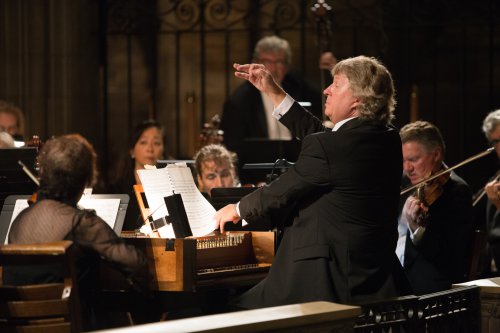American Classical Orchestra: Johann Sebastian Bach
A marvelously offered and idiosyncratic selection of one genius composer's remarkable music.

American Classical Orchestra and Chorus with Thomas Crawford, music director, at the podium (Photo credit: Andrei Matorin)
[avatar user=”Jean Ballard Terepka” size=”96″ align=”left” ] Jean Ballard Terepka, Music Critic[/avatar]Under the brilliant and dedicated direction of conductor and founder Thomas Crawford, the American Classical Orchestra embodies the very best of the period instrument tradition of seventeenth to nineteenth century music performance. Crawford’s goal is to replicate for modern audiences the sound and aesthetic feel of music in early modern chateaux and castles, chapels and cathedrals. Historical authenticity in performance, by definition, can’t ever be fully verifiable, but intellectual coherence, historical accuracy and artistic integrity are principles that, consistently adhered to, can effectively convey a coherent vision. This is Crawford’s consistent achievement in general, and it was in full display in the recent all-Bach American Classical Orchestra and Chorus concert at St. Ignatius of Antioch Church.
As Crawford stated in his useful, thoughtful pre-concert lecture, certain pieces by Bach ones he’s long wanted to perform. This concert offered an unusual collection of choral and instrumental Bach works; the pieces were arranged unusually, too, in an effort to highlight particular aspects of Bach’s counterpoint and compositional strategies. Crawford alternated 1720’s choruses – 1724 Es wartet alles auf dich (BWV 187/1726), Nun komm, der Heiden Heiland (BWV 62/1724), and Meine Seel erhebt den Herren (BWV 10/1724) and a 1728 Sinfonia (Ich habe meine Zuversicht, BWV 188)– with excerpts from early Cantatas all composed in 1707 or 1708.
The consistency – the from-the-very-beginning wholeness – of Bach’s genius was clear in this chronological arrangement. The kinds of writing techniques and subjects – the sequences and suspensions, chromaticisms and counterpoint intricacies – that Bach transformed from craft common to hundreds of composers to art unique to only a few became, over the years, Bach’s vehicles for examinations of all aspects of being human. In this single program, Crawford’s choice of music from almost all major liturgical seasons enabled his singers to present grief and joy, despair and hope, prayer and praise. And this they did marvelously.
The evening’s splendid assembled chorus consisted of four sopranos,four altos, three tenors and three basses. Of these, nine singers had solos; each solo was relatively brief; all were wonderful.
The acoustics in St. Ignatius of Antioch are perfect for performances such as this; one of Crawford’s great strengths as a conductor is his ability to maintain the subtlest of balances, allowing orchestra and chorus to reveal and support each other. The orchestral sound was subtly warm and lush, even as individual instruments were elegantly crisp and clean.
In his pre-concert talk, Crawford argued that much of Bach’s composing unfolded from his own intellectual and spiritual delight in the gift of his genius. In an anachronistic inversion of the movement to perform Baroque music as Baroque audiences might have heard it, Crawford and the American Classical Orchestra and Chorus gave us Bach’s music as Bach may never have heard it outside his own mind. Bach frequently complained about the musicians available to him; cantata singers – especially the choir boys and trebles – were often inadequately prepared. In that sense, when Bach’s music is performed by first rate instrumentalists and singers such as those associated with Thomas Crawford, we modern audiences are indeed hearing Bach’s imagination come alive. What a privilege that is.
The concert was warmly received by an engaged and enthusiastic audience who clearly knew their Bach stuff. The pre-concert lecture and the portion of the program notes specific to the individual works were genuinely educational and useful. (The opening essay in the lavishly produced program booklet, in contrast, was so overwrought and broad, making assertions about cultural and intellectual history that extended from Machiavelli and Karl Marx and offering a claim that Martin Luther’s 95 Wittenburg Theses were the “opening fusillade” of the “Revolution that began the Modern Age,” that it made an only minimal contribution to an understanding of Bach’s music.)
The high quality of the evening’s music and the artistic integrity of the performance assure ACO’s continued important place and leadership role in New York City’s rich classical music culture.
American Classical Orchestra and Chorus: Johann Sebastian Bach (November 29, 2016)
The Church of Saint Ignatius of Antioch
552 West End Avenue at 87th Street, in Manhattan
For more information: visit http://www.aconyc.org
Running time: one and 30 minutes with no intermission






Leave a comment